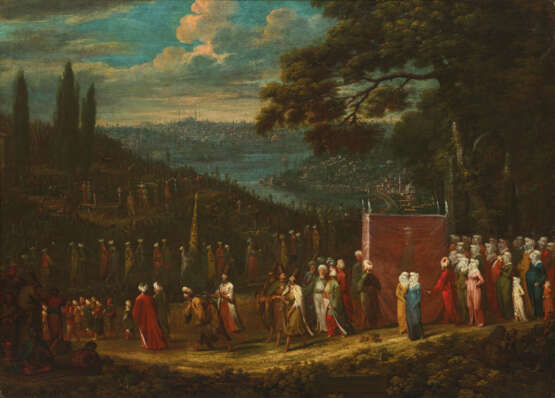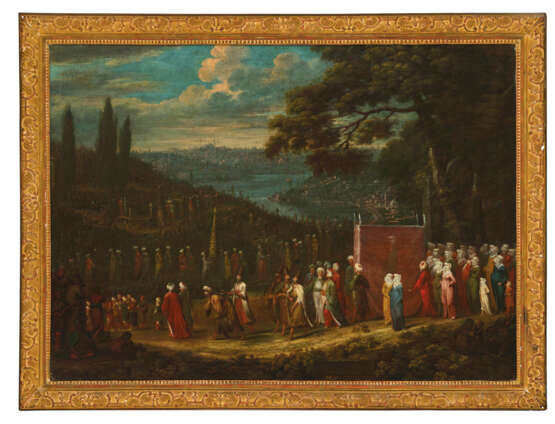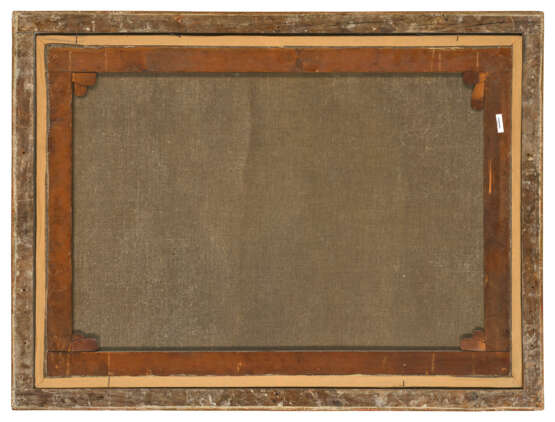ID 974877
Lot 25 | JEAN-BAPTISTE VANMOUR (VALENCIENNES 1671-1737 CONSTANTINOPLE)
Valeur estimée
€ 80 000 – 120 000
Le mariage turc
signé et localisé 'JB van mour pinxit / constantinopoli' (en bas, vers la droite, sur la pierre)
huile sur toile
61 x 84,4 cm. (24 x 33 1/4 in.)
Provenance
Acquis à Paris dans la première moitié du XXe siècle ; puis par descendance dans la famille, Paris.
Post lot text
JEAN-BAPTISTE VANMOUR, THE TURKISH WEDDING, SIGNED AND INSCRIBED, OIL ON CANVAS
Jean Baptiste Vanmour rests an enigma to this day. Born in Valenciennes, a province belonging to the Spanish Netherlands, in the second half of the 17th century, we know nothing about his artistic education. We do not know who his first teacher was, nor under which artist he completed his training in Paris, where he undoubtedly went. Nor do we know the exact year in which he reached Constantinople, having probably embarked from Marseille. Only a missive published in the Mercure de France announcing his death in 1737 in current-day Turkey gives a vague time frame to his activities in the East. It is only his paintings that offer precious evidence of his more than forty years spent in the Sublime Porte.
In the said missive it is given to understand that Vanmour was brought to the East by the ambassador Charles de Ferriol (1652-1722), his main patron and protector in the early days of the painter's life in the Ottoman Empire. It was for him that he carried out his first major commission, consisting of a hundred or so paintings produced between 1707 and 1708, which were to be engraved in order to disseminate Ottoman customs in the West. He was the first true witness to an Orient that up to this point had only existed in an imagined form; the artist recalled in a letter quoted by Boppe that as a painter he was "the only one in this country" (see Jean Baptiste Vanmour, Peintre de la Sublime Porte 1671-1737, [exh. cat.], Valenciennes, Musée des beaux-arts, 2009, p. 35). Unlike his predecessors in previous centuries, such as Bellini (1430-1516), Coecke van Aelst (1502-1550), Vanmour did not only spend time in the Levant, but stayed there for the rest of his life.
His paintings document events that might otherwise have been relegated to the world of the imaginary. A composition similar to our Turkish Wedding can be found in Ferriol's collection of engravings (Recueil de cent estampes représentant les diverses nations du Levant (...), Paris, 1714, p.25, pl.100, "Un mariage turc"). The customs are detailed: the bride, under a canopy carried by four men, is preceded by her parents and is led to her husband's new home; "happy if she is found beautiful and in good spirits; for he has never seen her", as the book states. The golden lances carried at the head of the procession symbolise fertility; these can be found in another painting by Vanmour in the Rijksmuseum (Amsterdam, inv. no. SK-A-2000), once in the collection of another of the painter's patrons, the Dutch ambassador Cornelis Calkoen (1696-1764).
Unlike other outdoor scenes by Vanmour, in The Turkish Wedding the artist did not limit the background to stretches of water illustrating the Bosphorus, but offered a wide panorama of the city. A depiction of the Blue Mosque can be seen from what might be Pera (today's Beyoğlu district), separated from the old city by the Golden Horn. The other wedding, probably Armenian, shows the customs of one of the main communities in Constantinople in the 18th century. Towards the centre, the young bride can be seen dressed in yellow and white clothes that are so constricting that they prevent her from making her way to the church unaided. The dancing figures at front of the procession can also be found in a painting in the Rijksmuseum (Amsterdam, inv. no. SK-A-2001), which makes it possible to identify the subject.
Vanmour’s influence continued after his death. His paintings travelled to all the major European capitals, fascinating painters who were eager to experience this exotic world without having to travel themselves. His the echo of his lively world can be found in Jean-Baptiste Pater's Sultan in the Harem (1695-1736) (private collection) with its group of figures in a frieze in the foreground, or Carle van Loo's turqueries (1705-1765) such as Madame de Pompadour as a sultana (Paris, Musée des Arts Décoratifs, inv. no. 26544). Over the centuries, whether in Boucher's (1703-1770) Orientales or Ingres's (1780-1867) Turkish bath, the scenes of this mysterious voyager-painter inspired all painters wishing to capture the essence of the East.
| Technique appliquée: | Huile sur toile |
|---|---|
| Style artistique: | Vieux Maître |
| Lieu d'origine: | Europe de l'Ouest, France, Asie, Europe, Turquie |
| Catégorie maison de vente aux enchères: | Peintures |
| Technique appliquée: | Huile sur toile |
|---|---|
| Style artistique: | Vieux Maître |
| Lieu d'origine: | Europe de l'Ouest, France, Asie, Europe, Turquie |
| Catégorie maison de vente aux enchères: | Peintures |
| Adresse de l'enchère |
CHRISTIE'S 9 Avenue Matignon 75008 Paris France | ||||||||||||||
|---|---|---|---|---|---|---|---|---|---|---|---|---|---|---|---|
| Aperçu |
| ||||||||||||||
| Téléphone | +33 (0)1 40 76 85 85 | ||||||||||||||
| Fax | +33 (0)1 40 76 85 86 | ||||||||||||||
| Conditions d'utilisation | Conditions d'utilisation | ||||||||||||||
| transport |
Service postal Service de messagerie ramassage par vous-même | ||||||||||||||
| Modes de paiement |
Virement bancaire | ||||||||||||||
| Heures d'ouverture | Heures d'ouverture
|





